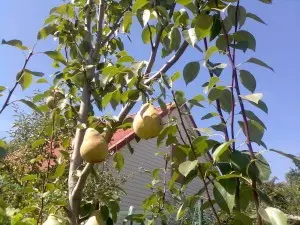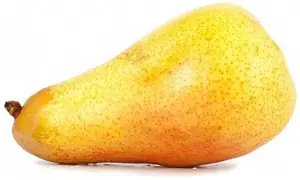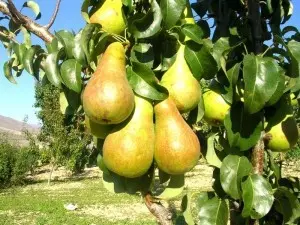The French old pear variety Bere Bosk is now the most common autumn variety in vast territories not only in Our Country, but also in Transcaucasia, Ukraine, Belarus, Armenia, Georgia, Moldova and Central Asia. This pear has only positive feedback from both professionals and amateur gardeners. It is especially appreciated for its large fruits, with high palatability.
Variety description
Bere Bosk pear belongs to high-growing varieties with a spreading, asymmetrical crown, pyramidal shape. The young tree has a high growth rate. Branches articulated, long. Fruits mainly on spears and kolchatka. Shoots greyish-brown, thick, with small lenticels and pressed buds. The leaves are large, ovoid, with an elongated tip, dark green in color with a short petiole 0,7-1,5 cm.
The flowers are wide open, large, collected in numerous inflorescences of 12-20 pieces, with oblong-oval petals and a notched wavy edge, resistant to cold. Styles of pistils are much shorter than stamens. Due to the late flowering period, the flowers are not exposed to spring frosts. A detailed description of this variety can be found in special reference books.

The fruits are large or medium-sized, weighing 190-250 g, bottle-elongated. However, often on the same tree, mature fruits can differ significantly in shape – from large pear-shaped to elongated. The skin is completely rusty, thin, rough, yellowish-brown or golden-rusty. The peduncle is thick, curved, there is no long funnel, the calyx is open. The seed nest is bulbous, large, the seeds are small. The flesh is very juicy, creamy, melting, tender, cream or white. It has a special almond flavor, pronounced arom, sweet. Fruits have a high concentration of sugars, ascorbic acid, active catechins. They ripen in the first half of September. They have good transportability, but the keeping quality is relatively short 27-35 days.
The pear begins to bear fruit from 7-8 years after planting. Propagated only on forest pear seed rootstocks or seedlings, preferably cultivars. If grafted onto quince, an intermediate insert is used.

Advantages and disadvantages
The greatest advantage of this variety is the high quality of the fruit, their large size. With age, the yield increases significantly. In addition, the tree is undemanding to soil conditions and bears fruit well on light soils in terms of mechanical composition with sufficient irrigation. The pear has a high resistance to many fungal diseases and scab.
One of the significant disadvantages of this variety include low winter hardiness and drought resistance.. So young, recently planted trees should definitely be covered for the winter, planted in a site protected from the wind by a wall of some building or large trees. An adult tree already tolerates harsh winters without harm. Since the crown is asymmetrical and spreading, it is necessary to regularly prune, giving the correct shape.

Pear Bere Bosk is not an early-growing variety. Although the fruits are held firmly on the tree and do not crumble even when ripe, their disadvantage is their non-simultaneous ripening and varied shape.
Video “Multi-varietal, family pear”
How to plant different varieties on a pear and how to grow a family pear is covered in detail in this video.









